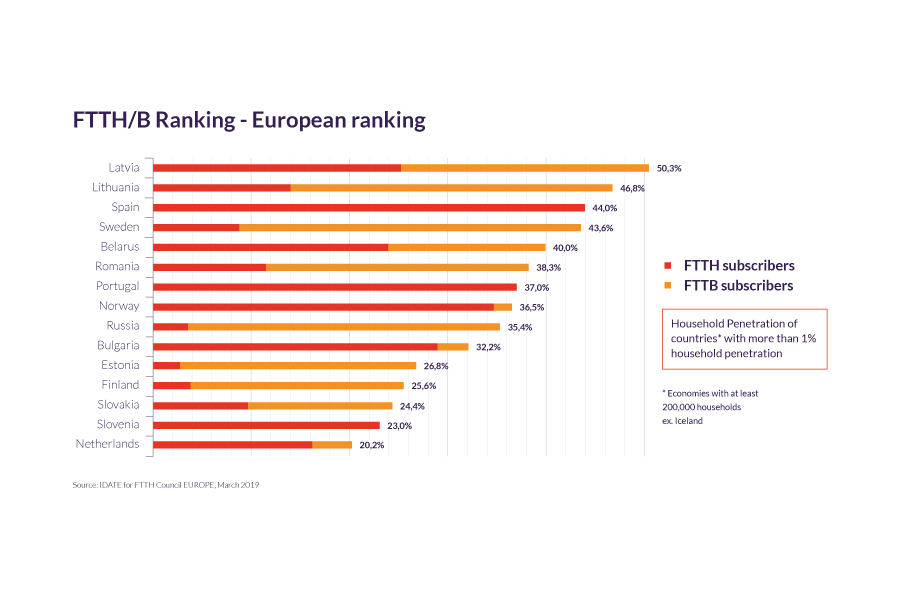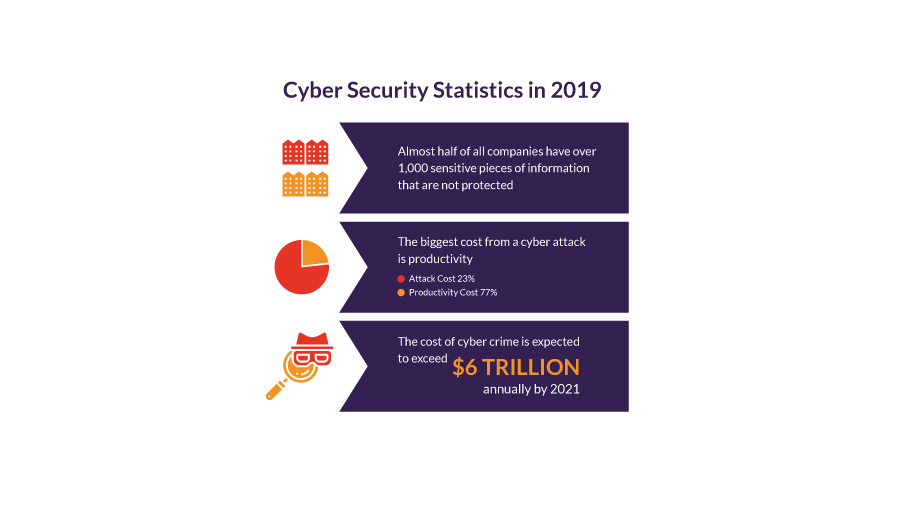
01 Oct The New Approach to Fiber Optic in Big Companies
1.Introduction
Globalization — and the needs in communication it entails — has meant that all the players in the business sector have had to adapt to changes as quickly as permitted by the technological conditions prevailing at any given moment. Barely a few decades ago, the mere possibility of wireless communication between two geographically distant points was considered a veritable achievement. Today, such a scenario in no way corresponds to the reality that companies need to provide and the users of communication networks demand.
It is now not simply a question of mobility. The difference lies in the speed and volume of data transmissions, bandwidth, portability, and the quality of communication. The standard today is set by the transmission of gigabytes of data in seconds, the sharing of videos in 4K quality, and high-definition calls. The absolute key to this qualitative leap forward — in a market with a turnover of 24 billion euros in Spain — has been the massive deployment of fibre optics.
Neutral wholesale carriers of reference such as lyntia are major strategic allies. Thanks to them, fibre optics, satellite communication and new generation networks are a practical reality, and their infrastructures and services favour a position of market leadership, according to certain standards that help them on their path to excellence and which can no longer be ignored.
2.Fibre optics in a new business scenario
The technology that has turned fibre optics into a reality, with all its available potential, has travelled a long way to reach the fullness it now enjoys today.
Although nearly a hundred and fifty years had to go by since Field laid the first transatlantic cable, it was not until the end of the 1980s that a fine glass cable covered the distance between Tuckerton (USA) and Penmarch (France), passing through Widemouth Bay (UK). That project, of enormous dimensions at that time, cost 335 million US dollars and involved the participation and investment of a dozen companies.
We are referring to the first transatlantic fibre-optic cable, TAT-8, which was in service until 2002. Fibre is now so readily available that we all use it every day in our work. New manufacturing methods have made it economical to produce.
We can now look at a map of fibre-optic coverage that reveals a substantially different scenario. Fibre optics is now a habitual traveling companion for end users. The Spanish market ended September 2018 with 8.04 million customers of fibre optics. The new generation network now accounts for 55% of the sector’s business.
These figures represent almost a twofold increase in fibre-optic technology over traditional broadband (ADSL), which lost more than a million customers over the course of 2018. By contrast, over the same period of time, the growth in the fibre-optic market numbered 1.45 million accesses.
This growth trend has been consolidated even further thus far in 2019. The same scenario of change in paradigm has affected traditional cable operators, with HFC technology. Just between January and September 2018, these companies have lost 200,000 lines.
One of the characteristics of the framework of action that fibre optics can offer companies is its guaranteed operation. Most of the customers that have experienced its benefits in terms of speed of transmission, bandwidth and reliability will not return to lines using ADSL technology, according to user feedback data provided by the companies themselves.
The difference in features and the possibility of implementing household services such as smart television — which is increasingly becoming a standard feature in end users’ basic audiovisual leisure setup — makes fibre optics a technological option of “no-return”.
In Spain’s specific case, the advent of fibre optics has placed this market in pole position in the whole of Europe, and globally only behind Japan and South Korea, according to data provided by the Organization for Economic Co-operation and Development (OECD). Throughout the rest of Europe, fibre optics and the migration process have not been as “dynamic” and swift as in the Spanish market.
2.1 Fibre optics is now a core strategy
In view of all this, Fibre to the Home (FTTH) technology is adopting a mainstream position in all development strategies among the main market players in Europe’s telecommunications market. This is especially so in the Spanish case – according to the FTTH Council Europe, Spain is the EU country with the highest rate of penetration of FTTH-. From R&D&i through to marketing and advertising departments, including those designed for implementing and maintaining networks and equipment, fibre optics and internet via satellite have ceased to be the future — associated with high investment — to become the present in a competitive market.

It is no surprise that both telecommunications operators and companies in general are anxiously seeking a solid platform for these strategies. A foundation that should consist of a highly heterogenous number of elements that provide an assurance of reliability and flexibility in management. It is not just a matter of paying attention to the bandwidth required for providing high-speed internet, as it is also important to have a dedicated line, with a redundancy that can adapt to needs, range of frequencies, etc.
In view of the need to consider so many aspects, the ideal thing would be for a company’s strategic partner, besides being familiar with the market’s specific needs and the options for covering those needs provided by the capacity area, to be able to take responsibility for the management and maintenance of its fibre-optic infrastructure. This means a balanced use of resources and the optimization of their benefits, at the same time as a sensitive element of the short- and medium-term development to be managed externally, without the need to train staff for these specific tasks.
Within this context, neutral carriers provide companies in the telecommunications sector with an opportunity to make the most of fibre optics, guaranteeing connectivity, broad coverage and sufficient capillary action to deploy services to the end user with the highest standards of quality in extensive areas of the territory in a market that may presume to be “muscular”, both in the present and in the medium and long runs.
3.Beyond fibre optics. The dawn of dark fibre
Another of the promising advantages of exploiting the deployment and connectivity provided by fibre optics involves squeezing out each available centimeter of “dark fibre”. This is a company’s gateway to development strategies that are not restricted by a possible increase in the demand for bandwidth or the number of users, among other aspects. Scaling approaches are much more appealing for investment if fibre optics “without light” is part of the equation.
“Dark fibre” in the Spanish market has an annual turnover of 165 million euros. It means that companies in the sector have thousands of kilometres of single-mode fibre infrastructure, to which they can add both preventive and corrective services, thereby enabling them to grow without increasing their costs in maintenance and repair tasks.
Always with the Spanish market in mind, almost 50% of the trunk aggregation networks used by the main operators are provided by the “dark fibre” wholesale market. The advantages for telecommunication companies .resorting to that wholesale market are that the companies owning dark fibre maintain an unwavering position of neutrality, as their business does not in any involve direct competition. What’s more, the contracts, in the short or very long term, allow designing and implementing strategies to suit each project’s needs.
3.1 A reliable, flexible and secure alternative
Dense wavelength division multiplexing renders it possible to carry different wavelengths on the same fibre-optic cable. This allows using them all at the same time, “lighting up” and resetting those that are needed depending on commercial requirements at each moment. Furthermore, the “dark fibre” provides operators with security and privacy, bandwidth and latency, as well as energy efficiency.
Both when wishing to enter the market at a competitive cost and when seeking to extend a network that is already up and running, and besides its scope and features, this can be done through an infrastructure already in place. This also ensures reliable support over long periods of time, and will enable companies to address both the increase in customers’ demand for bandwidth and the deployment of new business lines, associated with future developments, products and services.
4.The advantages of fibre optics for large corporations
The challenge of digital transformation is not exclusive to companies in the telecommunications sector. It involves, in a mainstream manner, each and every one of the spheres of corporate reality in large corporations. For these companies, the analysis and management of Big Data, cloud computing, digital trading, videoconferencing, the reliable connection of delocalized offices, and the secure transmission of key data — within a framework in which the business costs incurred by cyberattacks have exceeded six trillion dollars in 2019— call for high-performance connectivity solutions and a high level of security.

And that is precisely fibre optics’ “playing field”. It not only provides assurances in the distribution of data, reliability, speed and the maximum use of bandwidth, as it also involves symmetrical connections, the backing of 4G and 5G technology, efficient technical support and high availability, and active monitoring in real time, providing communications with absolute control and much easier and more efficient management.
A disconnected company is condemned to disappear. And the pursuit of any business activity without considering the fibre-optic market is tantamount to corporate suicide. According to reports by Zion Market Research, fibre optics is set to grow globally at an annual rate of 5.2% from now to 2022. Dealing with a digital transformation, with its implications in terms of its real application and obtaining future outcomes, without counting on fibre-optic technology is almost impossible. And let us not forget that digital transformation is synonymous with profits when addressing shareholders.
4.1 Finding a strategic partner, vital in the fibre-optic market
Prior to the development of the fibre-optic market, its implementation for large corporations could be difficult, slow and costly, with almost no application whatsoever in corporate strategies at that time. Today, neutral carriers have facilitated and “democratised” access to fibre optics for many companies, both in the telecommunications sector and in other markets.
And that possibility comes at just the right time, being received by the business community with some excitement. Their own socio-economic needs and those of their specific business sectors require a connectivity that is much more efficient — up to a hundred times more — and more secure than that available at the start of the millennium.
This means that neutral carriers may become ideal strategic partners for tackling the corporate world’s essential digital transformation; not only providing the infrastructure and the services required, which are much more numerous, generalised and with greater scope than a few years ago, but also by advising large corporations, providing them with expertise, technical maintenance, and support in the design of their own long-term strategies, as fibre optics has now been here to stay for some time, and there is a need to have a “player” who knows the game.
5.lyntia: leadership in cutting-edge technology
At this moment in time, lyntia is one such “player” with which to gain a competitive advantage, as a benchmark neutral carrier in Spain’s wholesale telecommunications market. Thanks to lyntia, large corporations seeking leadership in their industry may have fibre-optic-based connectivity services, with broad network coverage and extensive capillarity — with over 34,742 km of fibre optics deployed —. We provide services for local, national and international telecommunications operators, as well as carriers, OTTs, utilities, and data centres.
5.1 About us
The origin of lyntia is to be found in UFINET, a company incorporated in 1998 that in the last 20 years has undergone major growth, both at home in Spain and abroad, expanding its services and opening new markets in the Americas. At the time of writing, lyntia is providing all kinds of services in connectivity: dark fibre, capacity, FTTH wholesale service, VSAT, and co-location. All with a view to making communications possible, simple and secure.
In Spain, lyntia’s fibre-optic network covers the entire territory, connecting the country’s major cities and providing a service for around 1,200 locations. Furthermore, it has connections with the Iberian Peninsula’s main landing points for undersea cables.
lyntia has recently subscribed a historic agreement with the power utility Iberdrola, obtaining the exclusive long-term licence over the right of use of the surplus fibre network that the energy company has in Spain. The operation, valued at 260 million euros, will enable us to acquire the right to use a 15,000 km network of surplus fibre optics, improving the coverage in the Basque Country, Community of Valencia, Castilla La Mancha, and Metropolitan Madrid.
Our aspirations also involve internationalization. The aim is to link countries, join cities and connect companies. Hence the reason that lyntia today, besides connecting Spain’s major cities, has interconnections with France and Portugal.
Our values are reliability, as we are “obsessed” about providing a 100% secure network; commitment to our customers’ needs; passion for our work and the future that lies ahead, and simplicity to make things easy.
5.2 How can we help your company?
We provide our customers with the latest Fibre to the Home telecommunications technology. A wholesale access service to our FTTH network with the possibility of including backhaul, and with the option of delivery at any neutral node.
A last-mile residential and business service that is perfect for those operators wishing to use fibre in those places where they lack the necessary infrastructure. Furthermore, it is flexible under demand, as it adapts to each customer’s needs. The lyntia FTTH technology is managed, operated and maintained by our 24/7 NOC, with all the guarantees that entails.
We provide level 2 bitstream that is secure and transparent. A symmetric or asymmetric service, the possibility of including backhaul, management and maintenance provided by our 24/7 NOC, a broad range of Gigabit Passive Optical Network (GPON) capacity, and multi-operator equipment.
We also provide satellite solutions whenever an operator or company needs to reach where no one else can. We have ample satellite coverage through the main international satellites we operate with.
We provide bespoke solutions to cater for the needs of our strategic partners’ customers: optimization, design, settings and prioritization according to the applications and services based on the use of protocols for data, voice and video traffic. Our satellite network enables us to complement our fibre coverage via different satellite platforms or through roaming agreements with third parties.
Operating with lyntia provides the possibility of co-locating communication equipment in our infrastructures (Towers, CPDs and nodes) in Spain, and our POPs in Europe and the Americas. Our Data Centre service is available on the main POPs in Europe (London, Frankfurt, and Marseille) and the US (Miami and New York) to facilitate the use of fibre optics and the interconnection with other operators and/or other telecommunication integrators.
We thus streamline the generation of new links and provide high levels of availability and protection for the equipment and services installed.
Our co-location services help to protect critical data with the highest levels of operational security. All our nodes and CPDs are connected to our fibre-optic network.
We can thus provide flexible services with a broad range of hosting options to cater for our customers’ requirements. Furthermore, or data centres comply with all standards regarding reliability and security: air-conditioning, back-up power supply, fire control, controlled access, and supervisory systems according to Tier 3 standards.
5.3The lyntia fibre-optic service. Possible, straightforward and secure
At lyntia, we provide dynamic and secure capacity circuits with broad bandwidth through fibre optics, proactively managed 24/7 from end to end.
These circuits, distributed throughout all the cities and countries in which lyntia is present, provides services of trunk connectivity and capacity and an access network with speeds ranging from 2 Mbps to 100 Gbp, both nationally and internationally. Moreover, these circuits have high capillarity:
- 3.742 km of fibre deployed
- 97.730 near-net buildings
- 39.000 buildings connected
- 1.380 towns and cities connected
Furthermore, we are in a position to maximize the use our customers may make of our “dark fibre” infrastructure. Working with lyntia means a “dark fibre” with a broad bandwidth, either under leasing or the long-term licensing of the right of use.
This is the perfect solution for the rapid deployment of a Spanish or international operator. We provide an extensive network throughout Spain, connected to telephone exchanges, undersea cables and international link-ups. A single-mode fibre network that complies with standard ITU-T G.652. In addition, we provide a permanent 24/7 preventive and corrective maintenance service to ensure the finest availability.

